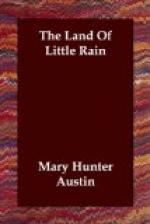Lingering on in the alpine regions until the first full snow, which is often before the cessation of bloom, one goes down in good company. First snows are soft and clogging and make laborious paths. Then it is the roving inhabitants range down to the edge of the wood, below the limit of early storms. Early winter and early spring one may have sight or track of deer and bear and bighorn, cougar and bobcat, about the thickets of buckthorn on open slopes between the black pines. But when the ice crust is firm above the twenty foot drifts, they range far and forage where they will. Often in midwinter will come, now and then, a long fall of soft snow piling three or four feet above the ice crust, and work a real hardship for the dwellers of these streets. When such a storm portends the weather-wise black-tail will go down across the valley and up to the pastures of Waban where no more snow falls than suffices to nourish the sparsely growing pines. But the bighorn, the wild sheep, able to bear the bitterest storms with no signs of stress, cannot cope with the loose shifty snow. Never such a storm goes over the mountains that the Indians do not catch them floundering belly deep among the lower rifts. I have a pair of horns, inconceivably heavy, that were borne as late as a year ago by a very monarch of the flock whom death overtook at the mouth of Oak Creek after a week of wet snow. He met it as a king should, with no vain effort or trembling, and it was wholly kind to take him so with four of his following rather than that the night prowlers should find him.
There is always more life abroad in the winter hills than one looks to find, and much more in evidence than in summer weather. Light feet of hare that make no print on the forest litter leave a wondrously plain track in the snow. We used to look and look at the beginning of winter for the birds to come down from the pine lands; looked in the orchard and stubble; looked north and south on the mesa for their migratory passing, and wondered that they never came. Busy little grosbeaks picked about the kitchen doors, and woodpeckers tapped the eves of the farm buildings, but we saw hardly any other of the frequenters of the summer canons. After a while when we grew bold to tempt the snow borders we found them in the street of the mountains. In the thick pine woods where the overlapping boughs hung with snow-wreaths make wind-proof shelter tents, in a very community of dwelling, winter the bird-folk who get their living from the persisting cones and the larvae harboring bark. Ground inhabiting species seek the dim snow chambers of the chaparral. Consider how it must be in a hill-slope overgrown with stout-twigged, partly evergreen shrubs, more than man high, and as thick as a hedge. Not all the canon’s sifting of snow can fill the intricate spaces of the hill tangles. Here and there an overhanging rock, or a stiff arch of buckthorn, makes an opening to communicating rooms and runways deep under the snow.




